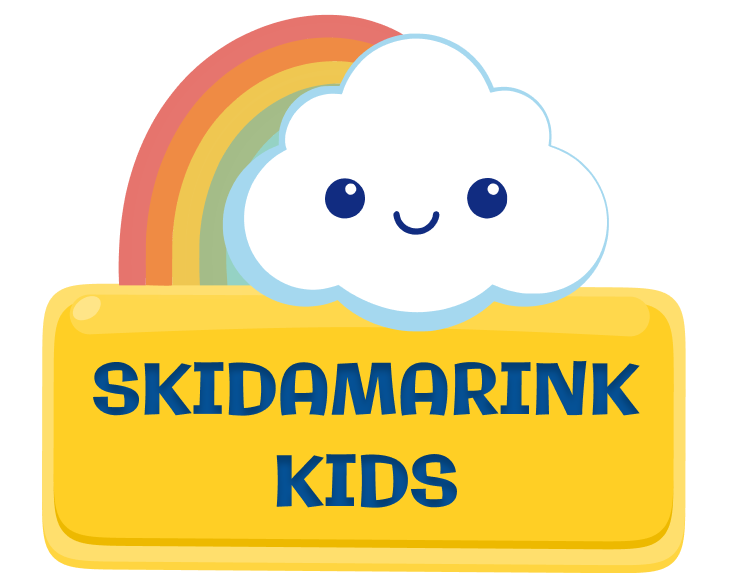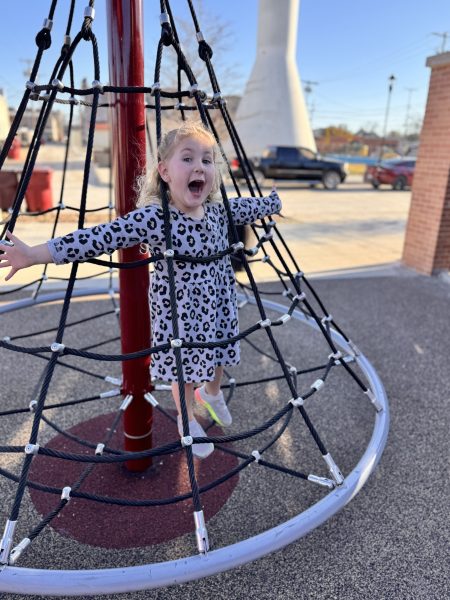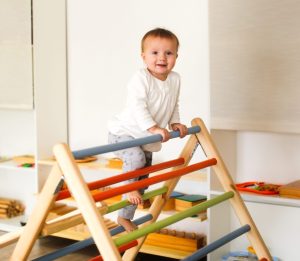Your child is bouncing off the walls at 4pm. Again. Before you lose your mind, understand this. That restless energy isn’t just normal. It’s actually essential! Gross motor activities for kids are the building blocks of healthy development. These purposeful movement experiences give your child’s developing brain and body the stimulation they desperately need. When children move, they’re not just burning energy. They’re actively building their brains!
Big body movement turns on the right side of the brain. This side acts as the “brake pedal” for impulse control and emotional regulation. That’s why children who move more throughout the day often show better focus, calmer behavior, and stronger self regulation skills.
Understanding these activities helps you transform everyday moments into powerful growth opportunities. Your child can build crucial skills while having fun. Plus, you don’t need expensive equipment or special training. Just your presence and encouragement make all the difference.
⭐ Gross Motor Activities for Kids Quick Start Here:
- Movement builds brain pathways for motor skills, focus, emotional control, and learning
- Kids need several hours of active play daily, not just structured exercise
- Start with 5-10 minute movement breaks throughout the day
- Heavy work activities (pushing, pulling, carrying) are amazing for regulation
- Follow your child’s interests – the best activities are ones they enjoy
- Check activities by age below for ideas you can start today!
What Are Gross Motor Activities for Kids?
Gross motor activities involve large muscle movements using the arms, legs, and core muscles. Think running, jumping, climbing, and throwing. These are the “big movements” your child naturally wants to do throughout the day.
These activities are powerful because they engage large muscle groups, involve whole body movement, and provide important sensory input to the developing brain. This input supports everything from balance and coordination to focus and emotional control.
Why Movement Matters for Development
Movement isn’t optional for healthy child development. It’s essential! These activities support brain development, emotional regulation, academic success, and social skills all at once.
When children move regularly, they build the neural pathways that support focus, self control, and learning readiness. Movement also helps children manage big emotions, build confidence, and practice social skills naturally through play.
Want to understand the science behind why movement matters so much? Read our companion blog Movement and Child Development: Why Moving to Grow for the full explanation of how physical activity shapes brain development, integrates primitive reflexes, and supports learning.
Physical Benefits of Movement
Movement builds strong, healthy bodies in a specific developmental sequence. Core stability develops first, followed by coordination, balance, body awareness, motor planning skills, and overall fitness. Each stage builds on the previous one, which is why you can’t skip steps in development.
These physical benefits grow naturally through play based movement when children have enough time and space to explore.
For more details on the developmental sequence and why it matters, see Child Self Regulation: The Brain Balance Key to Success.

Developmental Milestones and Movement
Children develop gross motor skills in a predictable pattern. However, every child moves through these stages at their own pace. Understanding typical development helps you give the right activities at the right time.
Infants (0-12 months)
Early movement sets the foundation for everything else. During this stage, focus on:
- Tummy time to strengthen neck, shoulder, and core muscles
- Rolling in both directions to build coordination
- Reaching and grasping for objects to develop eye hand coordination
- Crawling to create cross lateral brain connections
- Pulling to stand to build leg strength
- Cruising along furniture to practice balance
Each of these movements is crucial. Don’t rush them! Let your baby develop naturally.
Toddlers (1-3 years)
This stage brings exciting new abilities. Toddlers are learning to:
- Walk independently with increasing stability
- Climb stairs and furniture with growing confidence
- Run with improving coordination
- Kick and throw balls with developing aim
- Jump with two feet together
- Pull and push toys while walking
Toddlers need safe spaces to practice these emerging skills. They’ll fall often. That’s completely normal and necessary for learning!
Preschoolers (3-5 years)
Preschoolers show rapid improvement in coordination and control. They’re ready for:
- Hopping on one foot and skipping
- Riding tricycles or balance bikes
- Walking on balance beams or lines on the floor
- Throwing and catching with better accuracy
- Climbing playground equipment independently
- Running with control and stopping on command
This age group benefits from structured activities mixed with free play. They enjoy challenges but still need plenty of unstructured movement time.
School Age Children (6+ years)
Older children refine their skills and develop more complex abilities:
- Participating in organized sports and games
- Riding bikes with increasing distance and difficulty
- Swimming and water play with growing skills
- Jumping rope and playing complex playground games
- Learning dance or gymnastics moves
- Building coordination through team activities
School age children can handle more rules and structure. However, they still need daily opportunities for free, creative movement.
Age Appropriate Gross Motor Activities for Kids
Here are specific activities matched to your child’s developmental stage. These gross motor activities for kids are organized by age to help you find exactly what works right now. Remember, these are guidelines. Follow your child’s interests and abilities!
For Babies (0-12 months)
Supervised tummy time on various textures: Start from day one! Place your baby on their tummy on different surfaces like soft blankets, textured mats, or even on your chest. This strengthens their neck, shoulders, and core muscles. Make it engaging by getting down at their level, using colorful toys, or placing a mirror in front of them.
Rolling games with toys just out of reach: Once your baby can roll one direction, encourage rolling both ways. Place favorite toys slightly beyond their grasp to motivate them to roll toward the toy. This builds coordination and problem solving.
Sitting and reaching: Place you baby in a sitting position and help them prop on their arms until they learn to sit on their own. Place toys on each side of them to encourage trunk rotation and putting weight on their hands. This helps prepare them for transitional movements such as getting in and out of sitting and crawling positions.
Crawling obstacle courses with pillows and blankets: Create safe, soft obstacles using household items. Crawling builds incredible core stability and upper body strength needed for good fine motor skills like coloring and using a fork. This also creates cross lateral brain connections that support future learning and reading skills.
Supported standing with lots of encouragement: Hold your baby under their arms and let them bear weight on their legs. Bounce gently to music. This builds leg strength needed for walking later.
Playing with balls of different sizes: Roll balls back and forth while sitting. This develops hand eye coordination, tracking skills, and social interaction.
Water play during bath time: Splashing, kicking, and moving in water provides resistance that strengthens muscles. Plus, it’s sensory rich and fun!
For Toddlers (1-3 years)

Walking on different surfaces like grass, sand, and carpet: Each texture challenges balance differently and builds foot strength. Take shoes off when safe to enhance sensory input.
Climbing low furniture with supervision: Safe climbing on sturdy furniture or age appropriate playground equipment develops strength, spatial awareness, and confidence. Stay close but let them problem solve.
Dancing to music with simple movements: Put on music and move together! Dancing builds rhythm, coordination, and body awareness. Follow their lead and mirror their movements.
Playing with push and pull toys: Wagons, toy shopping carts, and pull along toys build leg strength and balance while making walking more fun and purposeful.
Ball rolling and gentle throwing: Roll balls back and forth. Practice throwing into baskets or targets. Start with large, soft balls and progress to smaller ones as coordination improves.
Dancing with scarves or ribbons: Lightweight scarves make movement visible and exciting. Wave them high, low, fast, and slow to build body awareness and coordination.
Balance walking on lines on the floor: Use painter’s tape to create lines, shapes, or paths on the floor. Walking along these lines builds balance and focus.
For Preschoolers (3-5 years)
Hopping and jumping games: Play hopscotch, jump over “rivers” made from pillows, “the floor is lava” or hop like different animals. Jumping is fantastic for leg strength and vestibular development.
Tricycle or balance bike riding: Pedaling builds leg strength while steering develops coordination. Balance bikes teach balance naturally without training wheels.
More complex obstacle courses: Set up courses that include jumping, crawling under things, balancing, and climbing over obstacles. Change them regularly to maintain interest and challenge.
Simple games with taking turns: Red Light Green Light, Duck Duck Goose, or simple ball games teach social skills while building physical abilities.
Target throwing with beanbags: Throwing at targets develops aim, motor planning, and hand eye coordination. Start with large, close targets and gradually increase difficulty.
Playground activities with climbing and sliding: Monkey bars, climbing walls, slides, and swings provide varied movement experiences that build strength, coordination, and confidence.
Vestibular movements that including head movements: Dancing, Swinging, spinning and upside down play are critical to develop balance, motor coordination and self regulation skills.
For School Age Children (6+ years)
Organized sports with emphasis on fun: Soccer, basketball, swimming, or gymnastics build specific skills while developing teamwork. Keep the focus on enjoyment and effort rather than winning.
Bike riding with increasing distance: Longer rides build endurance and leg strength. Explore new paths and trails to keep it interesting and adventurous.
Swimming and water play: Swimming is excellent full body exercise that builds cardiovascular fitness, strength, and coordination without impact on growing joints.
Jump rope games with rhymes: Jumping rope improves coordination, timing, and cardiovascular fitness. Add rhymes and tricks to make it more engaging and challenging.
Parkour inspired safe challenges: Jumping, climbing, and balancing in controlled environments builds body awareness, strength, and problem solving. Always prioritize safety and proper progression.
Building and creating with large materials: Cardboard boxes, large blocks, or outdoor building materials allow creative play combined with lifting, carrying, and construction movements.
Try challenging new skills: Learning new skills like roller skating or hula hoops are great for balance, core stability and motor coordination. These also improves body awareness, fitness and confidence. Roller skating is a great family activity as well.
Creating a Movement Rich Environment
Support these activities in your home by:
- Designating space for active play: Clear an area where movement is encouraged and safe
- Rotating movement toys to maintain interest: Keep some items accessible while storing others to bring out later
- Creating an obstacle course corner with cushions and tunnels: Dedicate a space that invites active play
- Using visual cues like tape on the floor for balance lines: Simple additions that encourage movement throughout the day. Blue painters tape works very well
- Keeping basic equipment accessible like balls, scarves, and balance toys: Easy access means more spontaneous movement
- Setting a timer for regular movement breaks: Build movement into your daily routine
Even 5 to 10 minutes of these activities several times daily gives real developmental benefits. Although duration of play does matter, regular short bursts throughout the day work wonders. So, don’t let lack of time prevent you from being consistent. Movement is a worth wild investment for you and your children.
Core Strengthening Activities
A strong core is essential for everything else:
- Child friendly yoga poses like plank, bridge, and downward dog: These poses build strength while teaching body awareness and breathing
- Wheelbarrow walking where you hold their legs while they walk on hands: This builds tremendous shoulder and core strength
- Crawling games through tunnels or obstacle courses: Any crawling variation strengthens the core naturally
- Ball exercises while lying on stomach: Lying on a large therapy ball while reaching for toys or the ground
- Hanging activities from secure bars or rings: Hanging builds grip strength and core stability
- Superman pose by lying on stomach and lifting arms and legs: This strengthens back muscles crucial for good posture
Core strength supports proper posture, better focus, and coordination for all other movements.

Interactive Gross Motor Activities for Kids
Games for Focus and Self Control
These activities improve attention, impulse control, and social skills:
- Simon Says with increasingly complex movements: This classic game builds listening skills and impulse control
- Red Light, Green Light for practicing stopping and starting: Teaches body control and following directions
- Freeze Dance for body control practice: Dance when music plays, freeze when it stops. Develops body awareness and ability to stop, pause and think
- Follow the Leader to build observation skills: Take turns being the leader with silly walks and movements
- Musical Chairs for social awareness: Teaches turn taking and handling disappointment gracefully
- Obstacle courses with specific movement patterns to follow: Following sequences builds working memory and motor planning
Pretend Play Movement Activities
Role playing builds creativity while encouraging movement:
- Running a pretend store or restaurant: Carrying items, stocking shelves, and moving around purposefully
- Acting out favorite stories with movement: Become the characters and move through the story actively
- Creating obstacle courses based on adventure themes: The floor is lava! Cross the ocean on stepping stones!
- Playing house with active roles: Cleaning, cooking, and caring for babies all involve purposeful movement
- Pretending to be different animals with distinctive movements: Hop like bunnies, stomp like elephants, slither like snakes
- Superhero play with jumping, running, and flying: Imagination makes movement exciting and meaningful
Eye Hand Coordination Activities
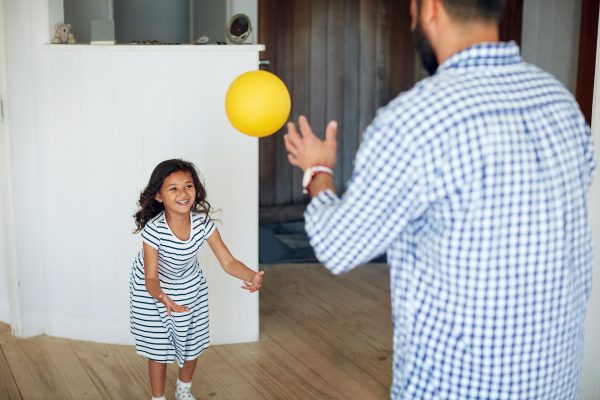
Improve visual and motor skills together:
- Tossing and catching different sized balls: Start large and soft, progress to smaller balls as skills develop
- Flying kites on windy days: Running while controlling the kite builds coordination and spatial awareness
- Balloon volleyball indoors: Keep the balloon in the air without letting it touch the ground
- Target games with bean bags: Toss into buckets, baskets, or hula hoops at varying distances
- Bubble popping with different body parts: Pop with fingers, elbows, knees, or feet for varied challenge
- Drawing or painting on vertical surfaces: Tape paper to walls or use an easel to strengthen shoulders
- Making and flying paper airplanes: Folding develops fine motor skills, throwing develops coordination
- Having distance competitions with paper airplanes: See whose plane flies farthest or straightest
- Creating different airplane designs to test: Problem solving combined with throwing practice
Heavy Work Activities
These activities are amazing for helping kids feel calm and organized. Heavy work gives the body deep pressure input that naturally settles the nervous system:
- Pushing or pulling wagons or laundry bsskets filled with toys or siblings: The resistance provides organizing sensory input
- Carrying groceries, laundry baskets, or stacks of books: Make them “strong helpers” with real tasks
- Playing wheelbarrow races with a parent: Hold their legs while they walk on hands
- Digging in sand, dirt, or snow: Shoveling and digging are excellent heavy work
- Raking leaves or helping with yard work: Real work that contributes and provides great sensory input
- Helping move light furniture: Pushing chairs to the table or moving cushions
- Animal walks like bear crawls or crab walks: These provide resistance through the joints
- Pushing against walls or doing wall push ups: Quick sensory input that’s available anywher
- Having gentle pillow fights: Supervised roughhousing in a safe, fun way
- Safe wrestling or rough and tumble play with parents: Controlled physical play builds strength and bonding
Heavy work is especially helpful before homework time, meals, or bedtime. It helps kids feel “ready” for what comes next.
Vestibular and Spinning Activities
The vestibular system needs lots of different types of movement. These activities build balance, coordination, and body awareness:
- Swinging (forward and back, side to side, or spinning): All types of swinging provide strong vestibular input
- Spinning in circles in both directions: Spin clockwise and counterclockwise for balanced input. If your child only spins to one direction, encourage spinning in other direction instead to avoid overstimulation and brain imbalance
- Rolling down hills: The combination of spinning and forward movement is powerful
- Doing somersaults and log rolls: Controlled rolling builds body awareness and vestibular strength
- Hanging upside down from monkey bars: Inversion provides intense vestibular stimulation
- Rocking in a rocking chair or hammock: Gentle, rhythmic movement is calming and organizing
- Going down slides in different positions: On belly, on back, sitting up, or feet first
- Riding on merry-go-rounds or spinning playground equipment: Classic playground favorites for good reason
- Playing on a therapy ball with parent support (sitting, bouncing, or lying on stomach): Always supervise closely
- Rocking on therapy ball while on stomach or back, reaching toward the floor or for toys while you hold there legs: This gives amazing vestibular input and brings oxygen-rich blood to the brain.
Start slowly with spinning activities. Some children love them while others get dizzy easily. Follow your child’s lead!
Crossing Midline Activities
These activities help the two sides of the brain work together better. They’re important for reading, writing, and coordination:
- Reaching across the body during play: Place items on one side, have them reach across with opposite hand
- Twisting movements during games: Any rotation of the trunk crosses midline
- Making figure 8 patterns in the air or on paper: Draw large figure 8s with both hands together
- Cross crawls where you march touching opposite knee to elbow: This integrates both sides of the brain
- Playing “Simon Says” with cross body movements: Touch left hand to right knee, right elbow to left knee
- Windmill arm movements touching opposite toes: Big, sweeping movements across the body
- Stirring big pots or bowls with crossing motions: Real cooking tasks that cross midline
You can add these movements into daily activities naturally. They don’t need to be separate “exercise time.”
Creative Building and Pretend Play
Sometimes the best movement activities come from imagination and creativity:
- Building cardboard box houses or forts to play in: Construction requires lifting, carrying, and spatial planning
- Creating cardboard ships for pretend sailing adventures: Imagination makes movement purposeful and exciting
- Making cardboard wings to pretend to fly around the yard: Running becomes flying!
- Building cardboard cars or trains to “drive” around: Push, pull, and navigate obstacles
- Creating rocket ships for space adventures: Blast off and explore new worlds
- Making cardboard box tunnels to crawl through: Crawling through adds movement to imaginative play
- Building castles or playhouses to play in: Large scale construction with lots of carrying and lifting
These activities combine creativity with whole body movement. Kids get to use their imagination while building strength and coordination.
Indoor Gross Motor Activities for Kids
When outdoor play isn’t possible, try these indoor movement options:
- Dance parties by cranking up music for creative movement: No equipment needed, just music and space
- Kid yoga with simple poses to promote flexibility and balance: Follow videos or create your own flow
- Tunnel crawling through play tunnels for sensory development: Pop up tunnels are perfect for indoor crawling
- Blanket forts that require climbing, crawling, and moving around: Building and playing in forts is active
- Obstacle courses using furniture and cushions: Get creative with what you have
- Pillow crashing by piling up pillows for jumping and sensory input: Safe jumping with soft landings
- Scavenger hunts hiding objects that require various movements to find: Add movement challenges at each location
Create a small “movement corner” in your home with items like a balance cushion, tunnel, and soft balls. This makes it easy for children to move throughout the day.
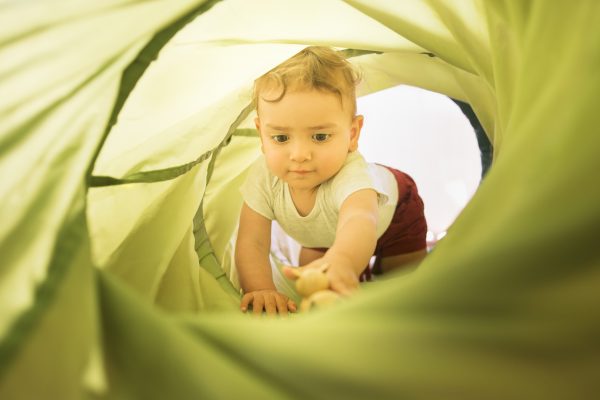
Quick Movement Breaks
Need to reset energy and improve focus? Try these short breaks every 30 to 45 minutes:
- Animal movements for 1 to 2 minutes: Hop like frogs, crawl like bears, fly like birds
- Cross lateral movements like touching opposite elbow to knee: Quick brain integration
- Wall push ups for quick sensory input: Push against a wall with all your strength
- Jumping jacks or hop sequences: Classic exercises that get blood flowing
- “Shake it out” whole body wiggles: Shake arms, legs, and whole body
- Stretching while reaching for the sky then touching toes: Wake up the body with stretches
- Bouncing and shaking game for connection and body awareness: See description below
Bouncing and Shaking Game:
Start by having your child gently bounce on their feet – just small, easy bounces. As they keep bouncing, gradually let the movement travel up through their body. The bouncing gets a little bigger and starts to shake their legs, then their hips, then their belly, and all the way up to their shoulders and arms. By the end, their whole body is bouncing and shaking in a silly, fun way!
This playful activity is wonderful for body awareness. It helps prevent stiffness, and it’s a great way to connect with your child through laughter and movement. Try doing it together – it becomes even sillier when you both look like wiggling noodles!
These quick breaks work especially well during transitions or when attention is fading. They’re perfect for homework time or after screen use!
Supporting Gross Motor Success
Remember these principles:
- Movement should be playful and fun, not forced
- The best activities are those your child enjoys and requests
- Consistent movement throughout the day beats occasional intense activity
- Join your child in movement to increase engagement
- Notice and comment on efforts rather than results
- Start simple and gradually increase difficulty as skills develop
Meeting Your Child Where They Are
Some children jump right into new movements with confidence. Others are more hesitant or cautious. Both are completely normal! If your child is hesitant to try new movements, meet them where they are.
Start with activities they feel comfortable doing. Then slowly introduce new challenges in small, gentle steps. Build their tolerance gradually without pushing too hard or too fast. The goal is to gently expand their comfort zone while respecting their feelings.
For example, if your child is nervous about spinning, start with gentle rocking first. Then try slow swinging. Eventually they may be ready for faster movement. Always move at your child’s pace, offering encouragement and support along the way.
Some children need more time to warm up to movement. That’s okay! Patience and consistency will help them build confidence over time. The key is making movement feel safe and fun, never scary or overwhelming.
The Power of Movement for Development
Here’s something incredible. When children engage in gross motor activities for kids regularly, they’re building more than just physical skills. They’re strengthening the neural pathways that support focus, emotional control, and learning readiness.
Movement turns on the right side of the brain. This side acts as your child’s internal “brake pedal” for impulse control and emotional regulation. The more children move, the stronger this develops!
To understand the complete picture of how movement shapes brain development, read Movement and Child Development: Why Moving to Grow
Closing Thoughts
Gross Motor Activities for kids are essential for healthy development. By including gross motor activities for kids into daily life, you’re supporting brain development, physical skills, emotional regulation, and social growth all at once.
The beauty of this approach is its simplicity. These activities don’t require expensive equipment or special training. Just your presence and encouragement make movement meaningful for your child.
As you explore these activities together, you’ll likely notice improvements in your child’s focus, mood, sleep, and overall development. Remember that every child develops at their own pace. Follow your child’s lead and celebrate their unique movement journey.
Looking for more ways to support your child’s development through movement?
Check out my blog on Outdoor Play Benefits for Kids: Essential Nature Time Activities and How to Calm Child Naturally: Brain-Supporting Activities
The Book “Balanced and Barefoot” by Angela J. Hanscom is a resource for great insights on movement and outdoor play.
– Kendra
